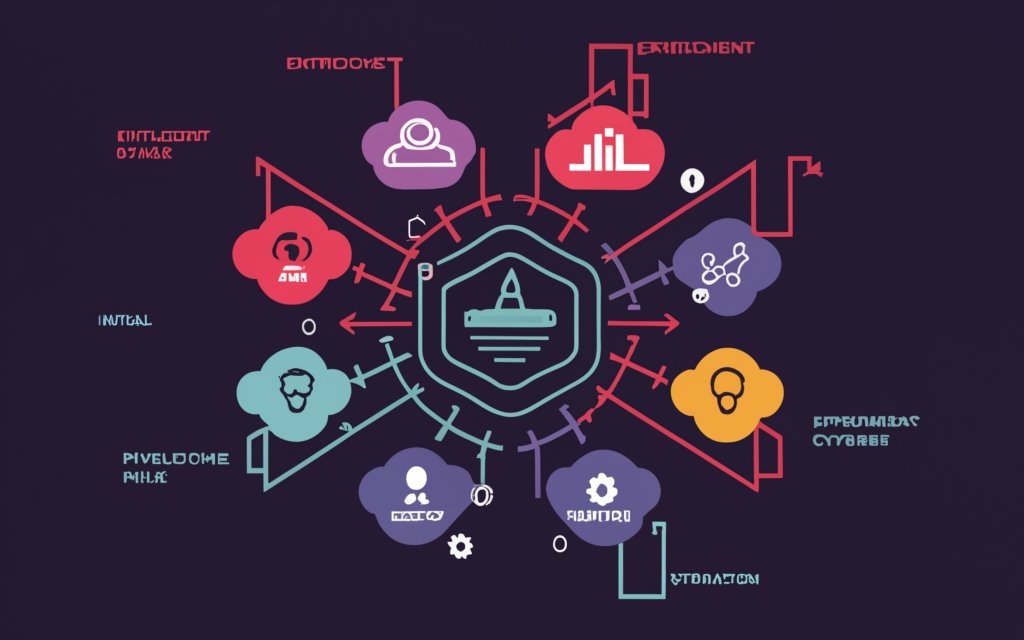When disaster strikes suddenly through catastrophe or compromise, resilient organizations survive by executing continuity plans rapidly restoring crucial operations and data – then learning lessons improving future response efficacies. Though essential, recovery from cyber intrusions requires additional considerations beyond infrastructure-impacting mishaps to sustain protections post-reinstatement.
Understanding The Anatomy of Damaging Cyber Intrusions
In contrast to abrupt infrastructure failures suddenly disrupting normal operations, sophisticated cyber intrusions frequently unfold gradually, often lurking undetected initially for months while adversaries entrench persistent footholds, escalate privileges, and clandestinely exfiltrate sensitive assets before revealing themselves. Attackers exploit this lengthy anonymous dwell time to expand control rather than rapidly trigger conspicuous damage. Subsequent actions then focus on intensifying disruption through tactics like:
Ransomware Encryption – Having mapped the victim’s high value information stores, attackers deploy ransomware to encrypt documents, databases, and shared directories across the environment. With essential data locked indefinitely unless firm negotiates payment, encryption represents extortion. Perpetrators often first exfiltrate copies of data to enable gradual leakage if coerced into providing decryption keys.
Wiping Malware – Some intrusions culminate with high-impact destructive events like unrecoverable endpoint formatting, database corruption, or wiping malware systematically deleting backups. With data stores ransacked beyond restoration, denial of availability continues indefinitely preventing regular business operations.
Denial-of-Service (DoS) – DoS attacks overwhelm infrastructure with excessive traffic from botnets temporarily disabling Internet-facing applications and services. Attacks disrupt connectivity or prevent legitimate access to affected systems.
Given extended breach exploitation windows before detection combined with adversaries’ attempted anonymity throughout, extreme difficulty exists attributing sponsorship and definitively identifying attack methodology to guide future cyber defense improvements. Yet lingering internal vulnerabilities that enabled initial access certainly necessitate hardening to prevent repeat incidents regardless of perpetrator.
By maintaining both preventative ingress controls and verifiable backup integrity securing crucial data outside production systems, resilient organizations can strategically recover on their schedule. With redundant accessible snapshots allowing restoration of business functionality, companies safely investigate lingering risks then comprehensively address residual attack surface shortcomings before reopening doors to customers.
Table: Stages of Sophisticated Cyber Intrusions
| Stage | Tactics |
| Initial Compromise | Phishing, Exploiting Public Vulnerabilities |
| Entrenchment | Disabling Security Tools, Persistence Mechanisms |
| Privilege Escalation | Credential Dumping, Lateral Movement |
| Exfiltration | Slow Data Transfers To Avoid Detection |
| Disruption | Ransomware, Malware, Denial-of-Service |
The modern enterprise technology footprint with Kubernetes container orchestrators, heavy serverless computing, hybrid multi-cloud deployments and a distributed remote workforce exposes exponentially greater attack surface than the legacy data center perimeter security model ever contemplated. Sophisticated hackers now have unlimited angles for exploit. While essential, prevention alone proves inadequate when persistence threats inevitably slip past defenses temporarily before eventual detection. Resilience obligates confirmed backup integrity ensuring restoration of impacted data remains possible throughout the inevitable intrusion lifecycle.
By taking an attacker’s perspective of the expanded breach anatomy facing modern organizations and instituting corresponding backup review, control redundancy and incident response provisions in addition to preventative access governance, companies comprehensively steel themselves across the spectrum of likely business disruption scenarios regardless of severity or cause. With resilience safeguards in place, adverse cyber events become managed crises rather than existential disasters.
The Need for Custom Strategies
Effective cyber incident response requires custom disaster recovery playbooks facilitating investigation, containment and managed restoration sequences distinct from generic continuity plans assuming universal damages rather than intelligent adversaries potentially persisting within restored environments post-cleanup absent exhaustive remediation.
Common necessary response customizations include:
- Forensic Analysis – Threat hunting remnants to determine initial access flaws for hardening
- Remediation Roadmaps – Multi-phase strategies balancing recovery urgency against security risks
- Dark Web Monitoring – Surfacing stolen data sale listings prompting victim notifications
With bespoke triage, organizations determine appropriate recovery pathways specific to breach types, system entanglements and regulatory obligations before reinstating functionality.
The Crucial Role of Incident Response
As essential as recovery procedures, resilient incident response provides operational choreography gracefully managing turbulence through:
- Severity Evaluation – Quantifying damages guiding teams appropriately
- Containment Strategy – Isolating infections limiting reach
- Eradication Sequencing – Removing artifacts methodically
- Business Continuity – Orchestrating interim workarounds sustaining productivity
With formal plans, organizations respond decisively while accelerating protections learning from missteps transforming future posture hardiness.
Determining the Root Cause
Before recovery completes, identifying initial intrusion vectors and deficiencies responsible proves essential preventing repeat exploits through the same routes.
Common root cause analyses reveal:
- Phishing lures duping staff despite training
- Unpatched software providing remote access
- Third-party vendor sloppiness exposing networks
- Insufficient data segregation enabling lateral traversal
With objective breach origin determination, risk reduction initiatives efficaciously target addressable weaknesses rather than speculative assumptions alone.
The Role of Compliance mandates
By enforcing basics like access control reviews, staff education requirements and backup verifications – regulations aim bolstering response competencies minimizing physician recovery expenses through greater self-sufficiency. Non-compliance risks steep fines and lawsuits atop primary losses.
Hence resilience and recovery carry legal obligations enforced through financial and legal penalties for negligence enabling eventual – yet avoidable – incidents inflicting damage scoped to protected data quantities and replacement costs absent better preparations across people, processes and technologies securing environments before turbulence.
Conclusion
With predictions indicating unprecedented scales of disruption across interconnected business foundations, solely preventing incidents appears unrealistic despite best efforts currently. Thus cyber resilience and disaster recovery command equal prioritization allowing continuity when compromise or calamity strikes through defense-in-depth and recovery insurance.
By architecting layered redundancies across preparation, detection and restoration while scrutinizing root factors once turbulence dissipates, organizations persist functioning through storms – both digital and physical – after verifying plan effectiveness required satisfying urgent regulatory obligations across tumultuous epochs ahead.
Frequently Asked Questions
How specifically do cyberattacks differ from physical disasters necessitating response customizations?
Whereas disasters damage infrastructure suddenly, cyber intrusions often unfold slowly remaining undetected for months allowing entrenchment. Later stages intensify disruption through ransomware, data wiping or service overload. Custom response playbooks facilitate investigation, containment and staged recovery specific to intelligent adversaries likely still embedded post-reinstatement after common continuity plan execution alone.
What common incident response plan components help organizations handle turbulence gracefully?
Mature strategies evaluate severity initially guiding teams appropriately, contain infections limiting reach, sequence eradication steps methodically, deliver interim workarounds sustaining business productivity smoothly and accelerate future protections by learning from response shortcomings transforming hardness through iterations.
Why should root cause analysis occur before recovery completes?
Determining initial intrusion vectors and deficiencies responsible allows preventing the same repeated exploitation routes. Commonly phishing dupes users, unpatched software permits access, vendors expose networks through negligence and insufficient data segregation allows traversal. With objective causations, risk reduction initiatives efficaciously target addressable weaknesses over guessing alone.
How are compliance mandates attempting to improve incident response competencies?
By standardizing protections like periodic access reviews, staff education and backup testing, regulators bolster self-sufficiency minimizing expenses through greater preparation across people, processes and technology securing environments ahead of turbulence. Non-compliance risks steep legal penalties and lawsuits compounding disruption costs further.
What role does resilience play recovering from cyber events?
By preserving data integrity outside compromised environments and maintaining response plans ready for activation when an intrusion inevitably manifests, organizations reinvent functionality rapidly after cleaning infections, integrate learned security improvements emerging stronger from tumultuous epochs ahead.

Kaushal Joshi is a versatile author with expertise in web development and technical writing. With a passion for both coding and effective communication, Kaushal has forged a dynamic career at the intersection of technology and content creation. His proficiency in web development is complemented by a talent for articulating complex technical concepts in clear and accessible language. Through his writing, Kaushal not only contributes to the evolving field of web development but also empowers readers with the knowledge to navigate the digital landscape. His commitment to bridging the gap between technology and understanding makes Kaushal Joshi a respected figure in both the web development and technical writing communities.

Leave a Reply